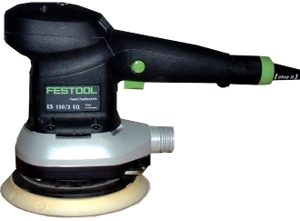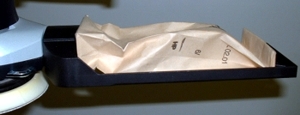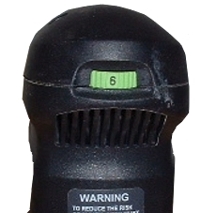Swirl Free Finish
The ES 150/3 is designed as a finishing sander and thus is less aggressive than the Festool Rotex and ES 150/5 models (this is an assumption on my part--I have not used the other models). With that and the price in mind, you would expect the ES 150/3 to produce a near swirl-free finish and it does. If you shine a light across a work piece sanded with an orbital or random orbital sander, and look at the surface closely, you will see hundreds if not thousands of small swirl marks etched into the surface. Generally most observers don't notice the marks--but woodworkers do. And such swirls have to effect the quality of the finished piece. The ES 150/3's small stroke and high stroke-per-minute capability produces a much finer finish than we have achieved with any other sander.
Dust Extraction
Dust extraction is excellent. Virtually all dust is evacuated. Extracting the dust with such an effective and easy to tolerate system makes the task of sanding much more enjoyable--no longer do we stand in our little dust tornado as we finish sand cabinets and the like. Also, the sanding disks seem to last much longer than those of our other sanders. You may have noticed in some of the pictures above that the disks literally wear out before they load up. Granted, the ES 150/3 is not the most aggressive sander on the market, but for the first time in my 30 year woodworking life, I actually save disks for use later when changing to higher/lower grits.
Low Vibration - Comfortable to Use
The sander produces very little vibration and the large handle and shape of the motor housing makes the sander very comfortable to use for even long periods. The large handle and reasonably light weight make it very easy to control.
Speed Control - Braking
The speed control and braking are very effective. Our Bosch does not have a brake, consequently, you have to be oh so careful when starting and stopping the sander and applying it to the surface to be sanded. The braking systems of other sanders are often a source of problems and gripes in the trade magazines. The Festool system, using a ring mounted on the sanding hub, works perfectly and is easily replaced on-site when it is no longer effective (wears out).
Six Inch Sanding Disks
I like the six inch sanding disks. It makes sanding a large surface just that much quicker and seems to add even more control to the sander, having the larger sanding surface in contact with the work. As I said earlier, the five inch disks of our other sanders seem puny in comparison.
Dust Filter Frame
So far, the only thing that I don't like about the ES150/3 is the large plastic frame used to support the dust bag/filter. It simply extends too far behind the sander (9 inches from the sander's base) and gets in the way when sanding within a confined space. If you're sanding a table top or similar flat surface, it is no problem. And frankly, it is not a big deal for us because we prefer to use the sander with a Festool CT dust extractor than the filter bag.
The Festool ES 150/3 produces a great sanded finish, what you would expect from a sander in this price range. The sander is a pleasure to use--the vibration and noise levels are less than our other sanders and the dust collection is remarkable. Health concerns aside, it's just downright annoying to work in an environment where dust is being exhausted from a sander. Cost of ownership should be lower than other sanders due to the extended life of the sanding disks and long expected life of the sander itself (three year warranty, 30-day money back). Not having used a Fein or a Dynabrade with dust collection, I can honestly say that I have not used a better sander than the ES 150/3, and thus give the ES 150/3 a FIVE.
| Rating:
| 
| out of 5!
|
Was this article helpful? Do you have any questions? E-Mail Us! We would love to hear from you!
|









